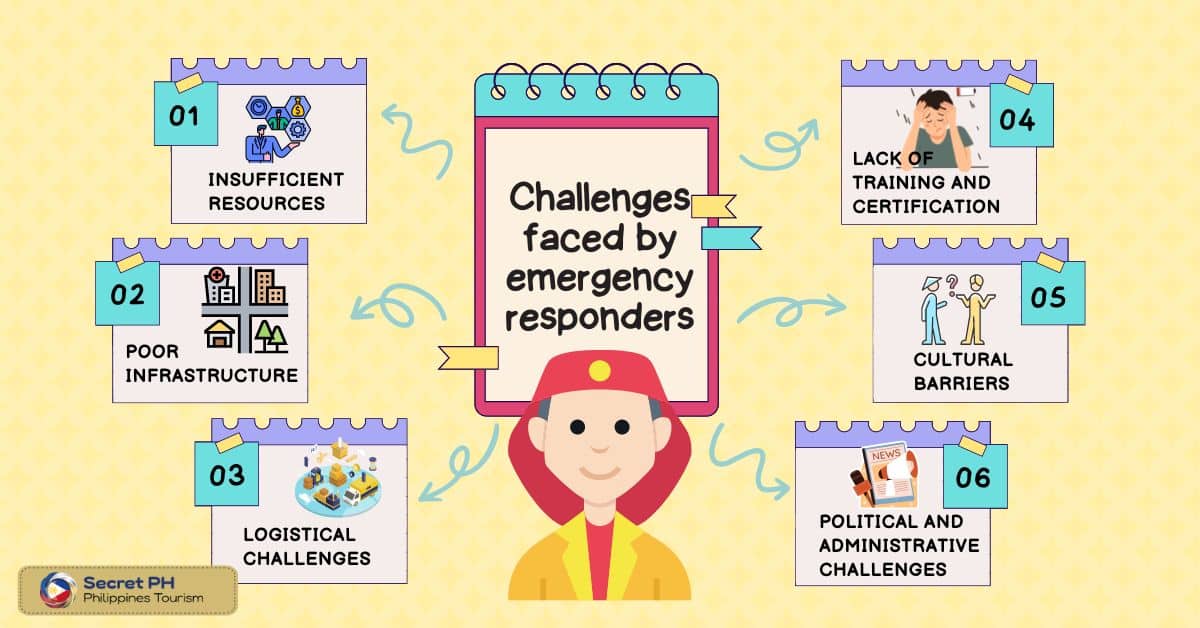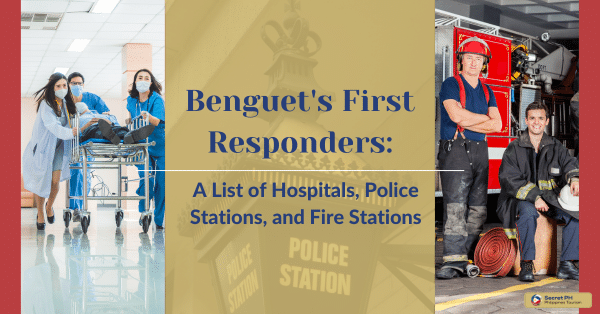The history of emergency services in the Philippines has evolved over time, starting with traditional methods in pre-colonial times to a modern, well-organized system. During the colonial period, Western medical practices and ambulance services were introduced. Today, technology and collaboration have improved emergency services, but challenges remain in providing effective aid in remote and disaster-prone areas.
Let’s trace the history of emergency services in the Philippines, exploring the significant events, advancements, and challenges that have shaped the Philippine emergency services system.

Emergency Services
Emergency Services are providers that are tasked with responding to sudden, urgent, and often dangerous situations. Whether it be a medical or car accident; or a natural disaster like a flood. They provide timely services to mitigate the impact the incidents have had on individuals and societies.
Emergency Services include paramedics or EMTs, fire-fighters, search and rescue teams and departments, military services. These heroic professionals risk their lives in providing safety to dangerous situations so life can return to normalcy for those impacted by these catastrophic events.

Early History of Emergency Services in the Philippines
The Early History of Emergency Services in the Philippines dates back to Spanish colonial times, when ambulance services were initiated by medical personnel and volunteers during a cholera outbreak.
The first attempts to create an organization to tackle catastrophe related issues came with the Sociedad General de Beneficiencia. It was founded in 1948, providing relief to all sorts of health-related disasters by creating hospital hospitals and orphanages. Since then, numerous developments have been made with regards to emergency services.
In 1947, two decades after its formation, the Philippine Red Cross was created with the purpose of helping victims affected by emergency situations. Numerous public agencies such as the Metropolitan Manila Development Authority (MMDA) have improved emergency response and preparedness in order to assess emergency occurrences.
Pre-Colonial Era
In the pre-colonial era of the Philippines, the concept of emergency services was limited and centered on traditional methods of responding to emergencies. This relied on the knowledge and resources available at the time. It has a cooperation of community leaders and the community as a whole.
Emergency services during this period were limited in scope and coverage. There was lack of professional emergency responders. The traditional system served as a foundation for the future development of emergency services in the Philippines. It paves the way for the advancements and improvements that would come in the centuries to follow.

Spanish Colonial Era
The Spanish colonial period in the Philippines marked a significant step forward in the development of emergency services. During this time, Western medical practices were introduced and hospitals and clinics were established. They provided more structured approach to healthcare.
The Spanish colonial government also played a role in providing emergency services. Also, recognizing the importance of responding effectively to emergencies and disasters. Although still limited in scope and coverage, the introduction of Western medical practices and the establishment of healthcare institutions represented a major advancement in the history.

American Colonial Period
The American colonial period in the Philippines marked another important step in the development of emergency services. During this time, ambulance services and communication systems were developed. They provide a more efficient and organized approach to responding to emergencies.
The American colonial government recognized the importance of emergency services and made significant investments. This period also saw the expansion of healthcare institutions, including hospitals and clinics. It helps improve the availability and quality of emergency services.
The American colonial period in the Philippines marked a major turning point in the history of emergency services. Laying the foundation for a more modern and well-organized system that would continue to evolve and improve in the decades to come.

Development of Emergency Services in the Philippines since Independence
Since achieving independence in 1947, the Philippines has made substantial progress in developing its emergency services. There were infrastructure to ensure the safety of its population. The government has funded the establishment and training of numerous firefighting brigades across the country. It has provided a vital resources both in developing urban centers and rural locations.
In addition to firefighting, the necessary personnel, technology and knowhow are present. This is to ensure respondents rapidly and efficiently to medical emergencies and natural disasters. The Philippine authorities have also placed a priority on providing effective aid to those affected by these events. The help includes provision of shelter, food and healthcare for vulnerable populations. This commitment by the government is helping more Filipinos than ever before access key emergency services which can help save lives.
Establishment of the Department of Health (DOH)
The Department of Health (DOH) is a Philippine government agency established in January 1898. It’s main goal is ensuring access to quality healthcare for all Filipinos. The DOH is responsible for implementing national health policies, programs. It has services that aimed at improving the health and well-being of the Filipino people.
The DOH works closely with local government units, healthcare providers, and other stakeholders to provide essential health services. It also includes maternal and child health, infectious disease control, and emergency medical services. Here are five major responsibilities of the DOH in this area:
| RESPONSIBILITIES OF THE DOH | |
| Coordination of Emergency Medical Services | The DOH coordinates with local government units, hospitals, and other healthcare providers to ensure the availability of emergency medical services and the provision of necessary medical care to those in need. |
| Disaster Preparedness and Response | The DOH is responsible for implementing disaster preparedness and response measures, including the development of guidelines and protocols for emergency medical services and the coordination of emergency response teams. |
| Monitoring and Management of Public Health Emergencies | The DOH monitors and manages public health emergencies, including the spread of infectious diseases and other health threats. |
| Provision of Medical Supplies and Equipment | The DOH provides medical supplies, equipment, and personnel to support emergency medical services, including the deployment of medical teams to affected areas. |
| Improvement of Emergency Medical Services | The DOH develops and implements policies and programs aimed at improving the quality of emergency medical services, including the training and certification of emergency medical technicians and the expansion of emergency medical services infrastructure. |

The Bureau of Fire Protection (BFP)
The Bureau of Fire Protection (BFP) is a Philippine government agency responsible for fire protection and firefighting services in the country. The BFP was created in 1991 through Republic Act 6975, which consolidated the various firefighting units under a single.
The main purpose of the BFP is to provide efficient and effective fire protection and firefighting services. It was to ensure the safety of the Filipino people and their properties. The BFP operates under the Department of the Interior and Local Government (DILG) and has a nationwide presence. There were fire stations located in major cities and municipalities across the country.
The BFP is also responsible for fire prevention, fire investigation, and the provision of fire safety education to the public. With its mission to protect lives and properties from fire, the BFP is an essential part of the Philippine emergency services network. They provide critical support to communities in times of crisis. The Bureau of Fire Protection (BFP) in the Philippines plays a crucial role in emergency response services. Here are five of its major responsibilities:

Firefighting and Fire Protection
The BFP is responsible for responding to and extinguishing fires, as well as protecting lives and properties from fire.
Fire Prevention and Investigation
The BFP also plays a role in fire prevention and investigation, helping to identify the cause of fires and implement measures to prevent future incidents.
Emergency Rescue Operations
The BFP is equipped to carry out emergency rescue operations, including search and rescue operations in the aftermath of natural disasters and other emergencies.
Fire Safety Education
The BFP provides fire safety education to the public, helping to raise awareness about fire safety measures and reduce the risk of fire incidents.
Disaster Response
The BFP also plays a key role in disaster response operations, providing firefighting and rescue services in the aftermath of natural disasters, such as typhoons and earthquakes. The BFP works closely with other emergency response agencies, including the Department of Health and the Philippine National Police, to ensure a coordinated response to emergencies.

Expansion of Emergency Medical Services (EMS) and ambulance services
Since gaining its independence in 1946, the Philippines has experienced tremendous growth in its emergency services system. This includes the expansion of Emergency Medical Services (EMS) and ambulance services. EMS initiatives have focused on improving response time and availability across rural areas as well as metropolitan cities.
Policy changes have delivered a stronger foundation for creating and sustaining an EMS network. It is capable of providing first-class healthcare in times of crisis or urgency. Local governments have invested funds into creating 911 hotlines and regionalized ambulance services. Theses are equipped with advanced medical equipment like defibrillators and oxygen tanks to respond better to a wide range of medical emergencies.

Current State of Emergency Services in the Philippines
The Current State of Emergency Services in the Philippines is concerning. As a nation considered to be both prone to natural disasters and heavily populated. These services are essential for responding quickly and efficiently to the health and safety needs of Filipinos.
Unfortunately, much remains to be done in terms of infrastructure investment, and improved inter-agency communication. Effectively allocating resources in order to create an environment where citizens can rest assured that emergency service providers will be available when needed. There is also a lack of financial resources allocated for training and equipping first responders.
These shortcomings have resulted in a situation where Filipino citizens often wait hours or even days for aid. The Philippine government must prioritize Emergency Services now if they are to provide the safe environment that Filipinos deserve.
Challenges faced by emergency responders
Emergency responders in the Philippines face a number of challenges in their efforts to provide effective and efficient emergency services to the public. Here are some of the key challenges:

- Insufficient Resources: Emergency responders often face a shortage of resources, including funding, equipment, and personnel, which can hamper their ability to respond to emergencies in a timely and effective manner.
- Poor Infrastructure: The Philippines is prone to natural disasters, such as typhoons, earthquakes, and volcanic eruptions, which can cause widespread damage to infrastructure and make it difficult for emergency responders to reach affected areas.
- Logistical Challenges: The Philippines is an archipelago of over 7,641 islands, which can present logistical challenges for emergency responders, particularly in rural and remote areas.
- Lack of Training and Certification: Some emergency responders may lack the training and certification needed to effectively respond to emergencies, which can negatively impact the quality of emergency services provided.
- Cultural Barriers: In some communities, cultural and linguistic barriers can make it difficult for emergency responders to effectively communicate with the public and provide necessary care.
- Political and Administrative Challenges: Emergency response efforts can sometimes be impacted by political and administrative challenges, including bureaucratic red tape, political interference, and limited cooperation between different agencies.
Technological advances in emergency response systems
Emergency services in the Philippines have gone through significant changes. To start off, with rapid advancements in communication technology, they are now more connected than ever before. This increased connectivity has enabled a more efficient level of coordination and collaboration between departments and provided faster response.
Many new technologies have been incorporated into emergency services for both medical purposes. There are telemedicine used for providing remote help to patients in isolated areas or territories, and crime prevention or law enforcement. Also, facial recognition software or drones for monitoring activities in specific locations.

Assistance from local and international partners to improve emergency services
In the wake of disasters that have plagued the country, safety measures and procedures such as evacuation protocols, medical advisories and outreach to vulnerable communities. To ensure an effective response to emergencies, assistance from both local and international partners has been increasingly relied on for training and technology upgrades to improve emergency services.

In Conclusion
The history of emergency services in the Philippines has seen tremendous progress over the years. Philippine emergency services have evolved to provide efficient and reliable responses to disasters and crisis. Today, these services are supported by robust training programs, improved telecommunication systems that can efficiently coordinate response activities.
The Department of Interior and Local Government (DILG) further manages some of these components and handles other pertinent matters related to local disaster preparedness. Communities from all Philippine regions are better able to safeguard themselves against dangerous occurrences. This makes it possible for Filipinos to enjoy greater peace-of-mind even during difficult times.








